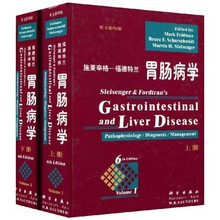胃肠病学(上下册)

目 录内容简介
VOLUME 1
Section I
Biology of the Gastrointestinal Tract
Chapter I
Gastrointestinal Hormones and
Neurotransmitters
Nigel W. Bunnett
John H. Walsh
TheChemical Messengers
The Receptors
Mechanisms of Signal Transduction
IntegrativeControl of Gastrointestinal Function
Conclusions
Chapter 2
Immunology and Inflammation of the
Gastrointestinal Tract
Martin E Kagnoff
GeneralCharacteristics of the Immune System
The Intestine as a Lymphoid Organ
Immunologic Diseases and Disorders
Chapter 3
Principles of Gastrointestinal Neoplasia
Anil K. Rustgi
Daniel K. Podolsky
Mechanisms of NormalCell Proliferation
Regulation of NormalCell Proliferation:
Signaling Pathways OfCell Growth Responses
Characteristics of MalignantCells
Mechanisms of Oncogenesis
Neoplasia-Associated Genes
Biology of Tumor Metastasis
Diagnostic Strategies:Current and Future
Approaches
Principles of Therapy:Current and Future
Section H
Approach to Patients with Symptoms and Signs
Chapter 4
Psychosocial Factors in Gastrointestinal
Disorders
Douglas A. Drossman
AConceptualization
Environmental Stress and Gastrointestinal Function
Brain-Gut Interactions
Psychoneuroimmunology
Clinical Relationships Between Psychosocial Factors
and Gastrointestinal Illness
Clinical Applications
Chapter 5
Abdominal Pain, Including the Acute
Abdomen
Robert E. Glasgow
Sean J. Mulvihill
Anatomic Basis of Pain
Stimulants of Pain
Types of Pain
An Approach to the Patient with Acute Abdominal
Pain
An Approach to the Patient withChronic
Abdominal Pain
Chapter 6
Chronic Functional Abdominal Pain
Douglas A. Drossman
The Physicians Experience withChronic Function
Abdominal Pain
Definition, Epidemioiogy, and HealthCare
Impact
Neurophysiology
Clinical Features
Clinical Assessment
Treatment Approach
Chapter 7
Dysphagia, Odynophagia, Heartburn, and
Other Esophageal Symptoms
Joel E. Richter
Dysphagia
Odynophagia
Heartburn (Pyrosis)
Globus Sensation
Chest Pain
Respiratory; Ear, Nose, and Throat; andCardiac
Symptoms
Chapter 8
Dyspepsia
K. McQuaid
Definition
Epidemiology
Causes of Organic Dyspepsia
Functional (Nonulcer) Dyspepsia
Evaluation
Empirical Treatment Versus Early Endoscopy
Treatment of Functional Dyspepsia
Chapter 9
Nausea and Vomiting
Makau Lee
Mark Feldman
The Act of Vomiting
Neural Pathways and Pathophysiology of Vomiting
Clinical Approach to Patients with Nausea and
Vomiting
Specific Syndromes Associated with Vomiting
Consequences of Vomiting
Therapy of Vomiting
Chapter !0
Diarrhea
Kenneth D. Fine
Definition of Diarrhea
Four Mechanisms of Diarrhea
Diagnostic Approach to Patients
Some Important Diarrheal Syndromes
Chapter 11
Intestinal Gas
Alessandra Strocchi
Michael D. Levitt
Volume andComposition of Bowel Gas
Sources of Bowel Gas
Clinical Gas Problems
Chapter 12
Fecal Incontinence
Lawrence R. Schiller
Prevalence
Mechanisms of Fecal Incontinence
Differential Diagnosis of Fecal Incontinence
Evaluation of Patients with Fecal Incontinence
Treatment
Management of Specific Situations
Chapter 13
Constipation
John E. Lennard-Jones
Presenting Symptoms
Epidemiology
ClinicalClassification
Pathophysioiogy
Constipation as a Manifestation of Systemic
Disorders
Constipation as a Manifestation ofCentral Nervous
Disease of the Extrinsic Nerve Supply to the Gut
Constipation Secondary to Structural Disorders of
theColon, Rectum, Anus, and Pelvic Floor
Drug Treatment MayCause or Aggravate
Constipation
Psychological Disorders asCauses or Aggravating
Factors inConstipation
Clinical Assessment
Investigation
Medical Treatment
ParticularClinical Problems
Chapter 14
Acute andChronic Gastrointestinal Bleeding
Loren Laine
Epidemiology
Manner of Presentation
Initial Assessment of the Patient
Resuscitation
Differeritiating Upper from Lower Gastrointestinal
Bleeding
Diagnostic Evaluation of Patients with
Gastrointestinal Bleeding
Specific Bleeding Lesions and Their Treatment
Chapter 15
Jaundice
Steven Lidofsky
Bruce E Scharschmidt
Determinants of Serum BilirubinConcentration
Differential Diagnosis of Jaundice
Diagnostic Approach to the Patient with Jaundice
Therapeutic Options
Section III
Nutrition in Gastroenterology
Chapter 16
The Malnourished Patient: Nutritional
Assessment and Management
Samuel Klein
Khursheed N. Jeejeebhoy
Basic NutritionalConcepts
Assessment of Nutritional Status
Refeeding the Malnourished Patient
Patients with Severe Malabsorption
Chapter 17
Enteral and Parenteral Nutrition
Samuel Klein
C. Richard Fleming
Enteral Nutrition
Parenteral Nutrition
Clinical Applications of Nutrition Support
Chapter 18
Obesity, Anorexia Nervosa, and Bulimia
Stephen D. Phinney
Charles H. Halsted
Obesity
Anorexia and Bulmia
Section IV
Topics Involving Multiple Organs
Chapter 19
Complications of Gastrointestinal Endoscopy
Harvey S. Young
Emmet B. Keeffe
GeneralComplications
Complications of Upper Endoscopy
Complications of Sigmoidoscopy andColonoscopy
Chapter 20
Diverticula of the Esophagus, Stomach, and
Small Bowel
William V Harford
Zenkers Diverticula
Diverticula of the Esophageal Body
Esophageal Intramural Pseudodiverticula
Gastric Diverticula
Duodenal Diverticula
Jejunal Diverticula
Chapter 21
Hernias and Volvulus of the Gastrointestinal
Tract
Katherine E. McArthur
Diaphragmatic Hernias
External Hernias of the Abdominal Wall
Groin Hernias (Including Inguinal Hernias)
Internal Hernias
Gastric Volvulus
Midgut Volvulus
Volvulus of the Large Bowel
Chapter 22
Foreign Bodies and Bezoars
K. Hamilton
D. Polter
Foreign Bodies
Bezoars
Conclusions
Chapter 23
Caustic Injury to the Upper Gastrointestinal
Tract
Peter M. Loeb
Abram M. Eisenstein
Caustic Agents
Pathogenesis and Pathology
Clinical Features
Diagnostic Studies
Treatment
Recommended Approach
LateComplications
Button Battery Ingestion
Chapter 24
Nonsteroidal Anti-Inflammatory Drugs and
Gastrointestinal Disease
ByronCryer
Introduction
Epidemioiogy
Mechanisms of Toxicity of NSAIDs
Clinical Manifestations of NSAID Injury
Throughout the Gastrointestinal Tract
Therapeutic Effects of NSAIDs in the Large
Intestine
Chapter 25
Abdominal Abscesses and Gastrointestinal
Fistulas
J. P. Minei
J.Champine
Abdominal Abscesses
Gastrointestinal Fistulas
Chapter 26
Protein.Losing Gastroenteropathy
Thomas A. Brasitus
Bruce M. Bissonnette
Definition and History
Etiology
Diagnosis
Treatment
Chapter 27
GastrointestinalComplications of Solid
Organ and Bone Marrow Transplantation
Sally A. S. Weisdorf
William D. Payne
Side Effects of Immunosuppressive Agents
InfectiousComplications
NutritionalComplications
MalignantComplications
Solid Organ Transplantation
Bone Marrow Transplantation
Graft-Versus-Host Disease
Chapter 28
Gastrointestinal Manifestations of the
Acquired Immunodeficiency Syndrome
C. Mel Wilcox
Scott L, Friedman
Evaluation and Management of Gastrointestinal and
Hepatobiliary Symptoms in AIDS
Diarrhea
Weight Loss
Odynophagia and Dysphagia
Abdominal Pain
Anorectal Disease
Jaundice and Hepatomegaly
Gastrointestinal Bleeding
Chapter 29
Effects on the Gut of Systemic Disease and
Other ExtraintestinalConditions
John R. Weber
JamesC. Ryan
Endocrine Disease
Pregnancy
Chapter 31
Anatomy and Developmental and Acquired
Anomalies of the Esophagus
John D. Long
RoyC. Orlando
Anatomy
Embryology
Developmental Anomalies
Acquired Anomalies
Chapter 32
Motor Physiology and Motor Disorders of
the Esophagus
Ray E.Clouse
N. E. Diamant
Overview of Normal Function
Innervation
Coordinated Esophageal Motor Activity
Mechanisms Producing Disordered Motility
Neoplastic Diseases
Hematologic Diseases
Rheumatologic andCollagen Diseases
Renal Disease
Neurologic Disease
Pulmonary Disease
Cardiac Disease
Infiltrative Diseases
Disorders of Lipid Metabolism
Chapter 30
Oral andCutaneous Manifestations of
Gastrointestinal Disease
Ginat W. Mirowski
17mothy G. Berger
Mouth and Tongue
MucocutaneousCandidiasis
Mucocutaneous Features of HIV Infection
Mucocutaneous Ulcerative Diseases
Vesiculobullous Diseases
Cutaneous Manifestations of Intestinal Disease,
Including Inflammatory Bowel Disease
Vascular andConnective Tissue Disorders
Cutaneous Markers Associated with Gastrointestinal
Malignancies
Malabsorption/Deficiency Syndromes
Vitamin Deficiencies
Pancreatic Disease and the Skin
Cutaneous Manifestations of Liver Disease
Parasitic Diseases of the Gut and Skin
Section V
Esophagus
Diagnosing Motor Disorders
Disorders of the UES andCervical Esophageal
Region
Achalasia
Other Hypermotility Disorders of the Distal
Esophagus
Disorders Restricted to the LES
Systemic Diseases Associated with Esophageal
Hypomotility
Chapter 33
Gastroesophageal Reflux Disease and Its
Complications
Peter J. Kahrilas
Definitions and Epidemiology
Histopathology of Esophagitis
Pathogenesis
Clinical Presentation and Natural History
Management
……
VOLUME 2
index
Section I
Biology of the Gastrointestinal Tract
Chapter I
Gastrointestinal Hormones and
Neurotransmitters
Nigel W. Bunnett
John H. Walsh
TheChemical Messengers
The Receptors
Mechanisms of Signal Transduction
IntegrativeControl of Gastrointestinal Function
Conclusions
Chapter 2
Immunology and Inflammation of the
Gastrointestinal Tract
Martin E Kagnoff
GeneralCharacteristics of the Immune System
The Intestine as a Lymphoid Organ
Immunologic Diseases and Disorders
Chapter 3
Principles of Gastrointestinal Neoplasia
Anil K. Rustgi
Daniel K. Podolsky
Mechanisms of NormalCell Proliferation
Regulation of NormalCell Proliferation:
Signaling Pathways OfCell Growth Responses
Characteristics of MalignantCells
Mechanisms of Oncogenesis
Neoplasia-Associated Genes
Biology of Tumor Metastasis
Diagnostic Strategies:Current and Future
Approaches
Principles of Therapy:Current and Future
Section H
Approach to Patients with Symptoms and Signs
Chapter 4
Psychosocial Factors in Gastrointestinal
Disorders
Douglas A. Drossman
AConceptualization
Environmental Stress and Gastrointestinal Function
Brain-Gut Interactions
Psychoneuroimmunology
Clinical Relationships Between Psychosocial Factors
and Gastrointestinal Illness
Clinical Applications
Chapter 5
Abdominal Pain, Including the Acute
Abdomen
Robert E. Glasgow
Sean J. Mulvihill
Anatomic Basis of Pain
Stimulants of Pain
Types of Pain
An Approach to the Patient with Acute Abdominal
Pain
An Approach to the Patient withChronic
Abdominal Pain
Chapter 6
Chronic Functional Abdominal Pain
Douglas A. Drossman
The Physicians Experience withChronic Function
Abdominal Pain
Definition, Epidemioiogy, and HealthCare
Impact
Neurophysiology
Clinical Features
Clinical Assessment
Treatment Approach
Chapter 7
Dysphagia, Odynophagia, Heartburn, and
Other Esophageal Symptoms
Joel E. Richter
Dysphagia
Odynophagia
Heartburn (Pyrosis)
Globus Sensation
Chest Pain
Respiratory; Ear, Nose, and Throat; andCardiac
Symptoms
Chapter 8
Dyspepsia
K. McQuaid
Definition
Epidemiology
Causes of Organic Dyspepsia
Functional (Nonulcer) Dyspepsia
Evaluation
Empirical Treatment Versus Early Endoscopy
Treatment of Functional Dyspepsia
Chapter 9
Nausea and Vomiting
Makau Lee
Mark Feldman
The Act of Vomiting
Neural Pathways and Pathophysiology of Vomiting
Clinical Approach to Patients with Nausea and
Vomiting
Specific Syndromes Associated with Vomiting
Consequences of Vomiting
Therapy of Vomiting
Chapter !0
Diarrhea
Kenneth D. Fine
Definition of Diarrhea
Four Mechanisms of Diarrhea
Diagnostic Approach to Patients
Some Important Diarrheal Syndromes
Chapter 11
Intestinal Gas
Alessandra Strocchi
Michael D. Levitt
Volume andComposition of Bowel Gas
Sources of Bowel Gas
Clinical Gas Problems
Chapter 12
Fecal Incontinence
Lawrence R. Schiller
Prevalence
Mechanisms of Fecal Incontinence
Differential Diagnosis of Fecal Incontinence
Evaluation of Patients with Fecal Incontinence
Treatment
Management of Specific Situations
Chapter 13
Constipation
John E. Lennard-Jones
Presenting Symptoms
Epidemiology
ClinicalClassification
Pathophysioiogy
Constipation as a Manifestation of Systemic
Disorders
Constipation as a Manifestation ofCentral Nervous
Disease of the Extrinsic Nerve Supply to the Gut
Constipation Secondary to Structural Disorders of
theColon, Rectum, Anus, and Pelvic Floor
Drug Treatment MayCause or Aggravate
Constipation
Psychological Disorders asCauses or Aggravating
Factors inConstipation
Clinical Assessment
Investigation
Medical Treatment
ParticularClinical Problems
Chapter 14
Acute andChronic Gastrointestinal Bleeding
Loren Laine
Epidemiology
Manner of Presentation
Initial Assessment of the Patient
Resuscitation
Differeritiating Upper from Lower Gastrointestinal
Bleeding
Diagnostic Evaluation of Patients with
Gastrointestinal Bleeding
Specific Bleeding Lesions and Their Treatment
Chapter 15
Jaundice
Steven Lidofsky
Bruce E Scharschmidt
Determinants of Serum BilirubinConcentration
Differential Diagnosis of Jaundice
Diagnostic Approach to the Patient with Jaundice
Therapeutic Options
Section III
Nutrition in Gastroenterology
Chapter 16
The Malnourished Patient: Nutritional
Assessment and Management
Samuel Klein
Khursheed N. Jeejeebhoy
Basic NutritionalConcepts
Assessment of Nutritional Status
Refeeding the Malnourished Patient
Patients with Severe Malabsorption
Chapter 17
Enteral and Parenteral Nutrition
Samuel Klein
C. Richard Fleming
Enteral Nutrition
Parenteral Nutrition
Clinical Applications of Nutrition Support
Chapter 18
Obesity, Anorexia Nervosa, and Bulimia
Stephen D. Phinney
Charles H. Halsted
Obesity
Anorexia and Bulmia
Section IV
Topics Involving Multiple Organs
Chapter 19
Complications of Gastrointestinal Endoscopy
Harvey S. Young
Emmet B. Keeffe
GeneralComplications
Complications of Upper Endoscopy
Complications of Sigmoidoscopy andColonoscopy
Chapter 20
Diverticula of the Esophagus, Stomach, and
Small Bowel
William V Harford
Zenkers Diverticula
Diverticula of the Esophageal Body
Esophageal Intramural Pseudodiverticula
Gastric Diverticula
Duodenal Diverticula
Jejunal Diverticula
Chapter 21
Hernias and Volvulus of the Gastrointestinal
Tract
Katherine E. McArthur
Diaphragmatic Hernias
External Hernias of the Abdominal Wall
Groin Hernias (Including Inguinal Hernias)
Internal Hernias
Gastric Volvulus
Midgut Volvulus
Volvulus of the Large Bowel
Chapter 22
Foreign Bodies and Bezoars
K. Hamilton
D. Polter
Foreign Bodies
Bezoars
Conclusions
Chapter 23
Caustic Injury to the Upper Gastrointestinal
Tract
Peter M. Loeb
Abram M. Eisenstein
Caustic Agents
Pathogenesis and Pathology
Clinical Features
Diagnostic Studies
Treatment
Recommended Approach
LateComplications
Button Battery Ingestion
Chapter 24
Nonsteroidal Anti-Inflammatory Drugs and
Gastrointestinal Disease
ByronCryer
Introduction
Epidemioiogy
Mechanisms of Toxicity of NSAIDs
Clinical Manifestations of NSAID Injury
Throughout the Gastrointestinal Tract
Therapeutic Effects of NSAIDs in the Large
Intestine
Chapter 25
Abdominal Abscesses and Gastrointestinal
Fistulas
J. P. Minei
J.Champine
Abdominal Abscesses
Gastrointestinal Fistulas
Chapter 26
Protein.Losing Gastroenteropathy
Thomas A. Brasitus
Bruce M. Bissonnette
Definition and History
Etiology
Diagnosis
Treatment
Chapter 27
GastrointestinalComplications of Solid
Organ and Bone Marrow Transplantation
Sally A. S. Weisdorf
William D. Payne
Side Effects of Immunosuppressive Agents
InfectiousComplications
NutritionalComplications
MalignantComplications
Solid Organ Transplantation
Bone Marrow Transplantation
Graft-Versus-Host Disease
Chapter 28
Gastrointestinal Manifestations of the
Acquired Immunodeficiency Syndrome
C. Mel Wilcox
Scott L, Friedman
Evaluation and Management of Gastrointestinal and
Hepatobiliary Symptoms in AIDS
Diarrhea
Weight Loss
Odynophagia and Dysphagia
Abdominal Pain
Anorectal Disease
Jaundice and Hepatomegaly
Gastrointestinal Bleeding
Chapter 29
Effects on the Gut of Systemic Disease and
Other ExtraintestinalConditions
John R. Weber
JamesC. Ryan
Endocrine Disease
Pregnancy
Chapter 31
Anatomy and Developmental and Acquired
Anomalies of the Esophagus
John D. Long
RoyC. Orlando
Anatomy
Embryology
Developmental Anomalies
Acquired Anomalies
Chapter 32
Motor Physiology and Motor Disorders of
the Esophagus
Ray E.Clouse
N. E. Diamant
Overview of Normal Function
Innervation
Coordinated Esophageal Motor Activity
Mechanisms Producing Disordered Motility
Neoplastic Diseases
Hematologic Diseases
Rheumatologic andCollagen Diseases
Renal Disease
Neurologic Disease
Pulmonary Disease
Cardiac Disease
Infiltrative Diseases
Disorders of Lipid Metabolism
Chapter 30
Oral andCutaneous Manifestations of
Gastrointestinal Disease
Ginat W. Mirowski
17mothy G. Berger
Mouth and Tongue
MucocutaneousCandidiasis
Mucocutaneous Features of HIV Infection
Mucocutaneous Ulcerative Diseases
Vesiculobullous Diseases
Cutaneous Manifestations of Intestinal Disease,
Including Inflammatory Bowel Disease
Vascular andConnective Tissue Disorders
Cutaneous Markers Associated with Gastrointestinal
Malignancies
Malabsorption/Deficiency Syndromes
Vitamin Deficiencies
Pancreatic Disease and the Skin
Cutaneous Manifestations of Liver Disease
Parasitic Diseases of the Gut and Skin
Section V
Esophagus
Diagnosing Motor Disorders
Disorders of the UES andCervical Esophageal
Region
Achalasia
Other Hypermotility Disorders of the Distal
Esophagus
Disorders Restricted to the LES
Systemic Diseases Associated with Esophageal
Hypomotility
Chapter 33
Gastroesophageal Reflux Disease and Its
Complications
Peter J. Kahrilas
Definitions and Epidemiology
Histopathology of Esophagitis
Pathogenesis
Clinical Presentation and Natural History
Management
……
VOLUME 2
index
目 录内容简介
《胃肠病学(上下册)》是世界上专业的关于消化系统疾病诊断、治疗的专著,共有l69位世界知名教授参加编写。全书全面描述了消化系统的基础科学,包括近年来被广为重视的分子生物学和细胞生物学,以及临床常见器官疾患的组织病理、病理生理及实验室指标的异常等,系统介绍了多器官疾病(如艾滋病)的诊断、治疗及护理。《胃肠病学(上下册)》的特点是以专题的形式对消化系统疾病列出问题,并进行了详尽的讨论。
《胃肠病学(上下册)》可供消化科医师、消化专业研究生和科研人员学习、研究、收藏。《胃肠病学(上下册)》包括:《胃肠病学(上册)》和《胃肠病学(下册)》。
《胃肠病学(上下册)》可供消化科医师、消化专业研究生和科研人员学习、研究、收藏。《胃肠病学(上下册)》包括:《胃肠病学(上册)》和《胃肠病学(下册)》。
比价列表
公众号、微信群
 缺书网
缺书网微信公众号
 扫码进群
扫码进群实时获取购书优惠






